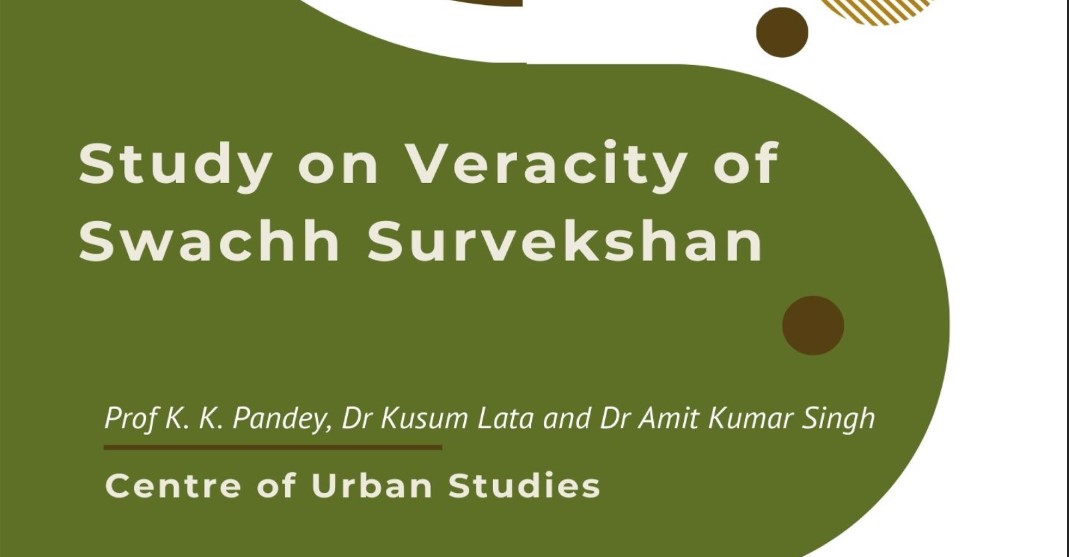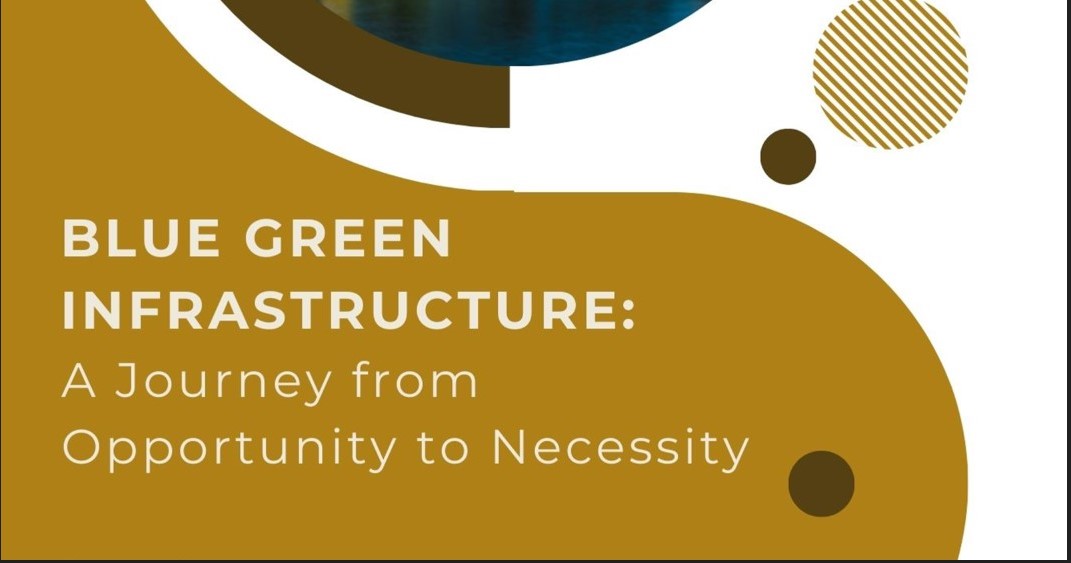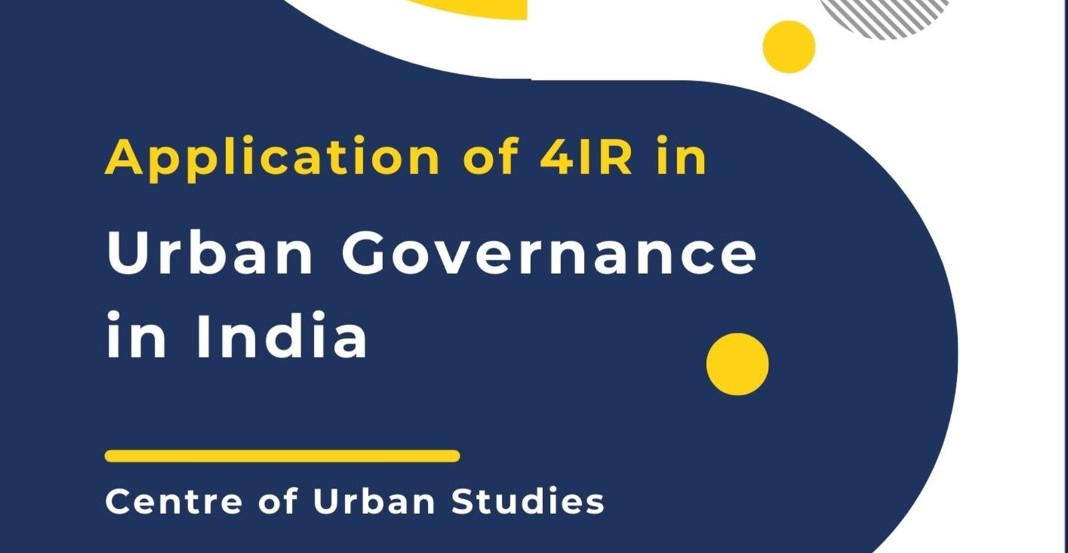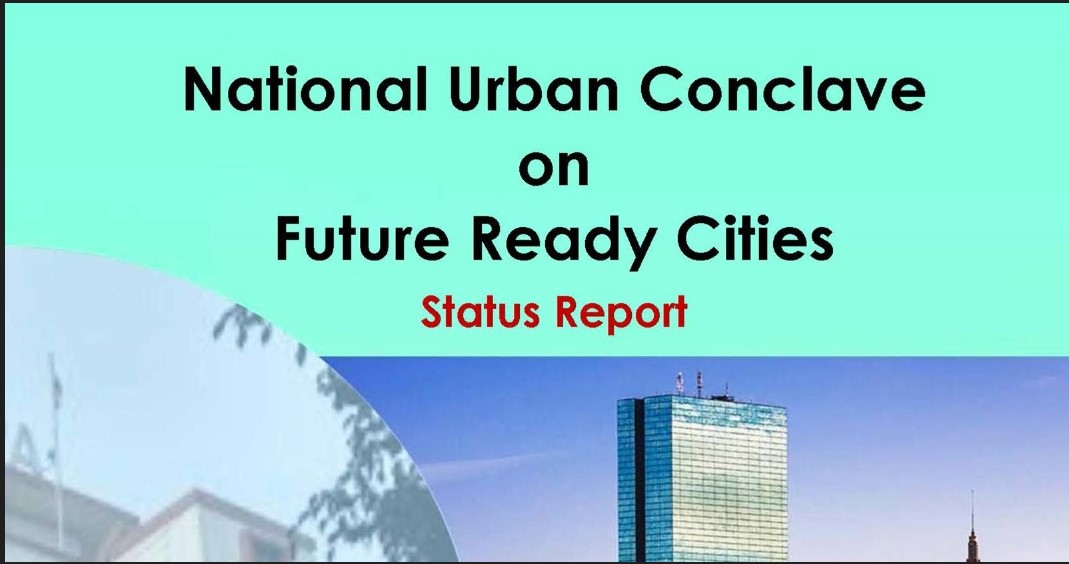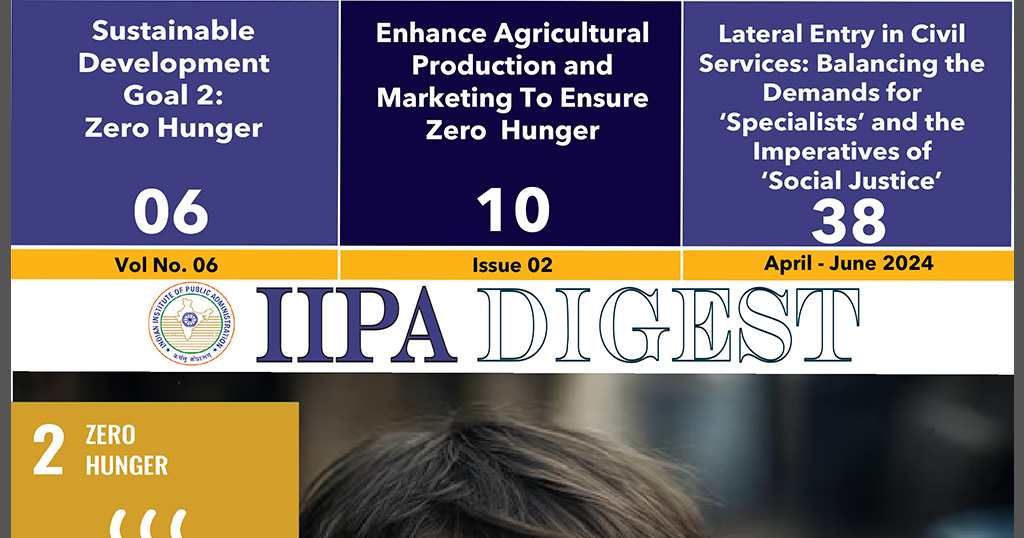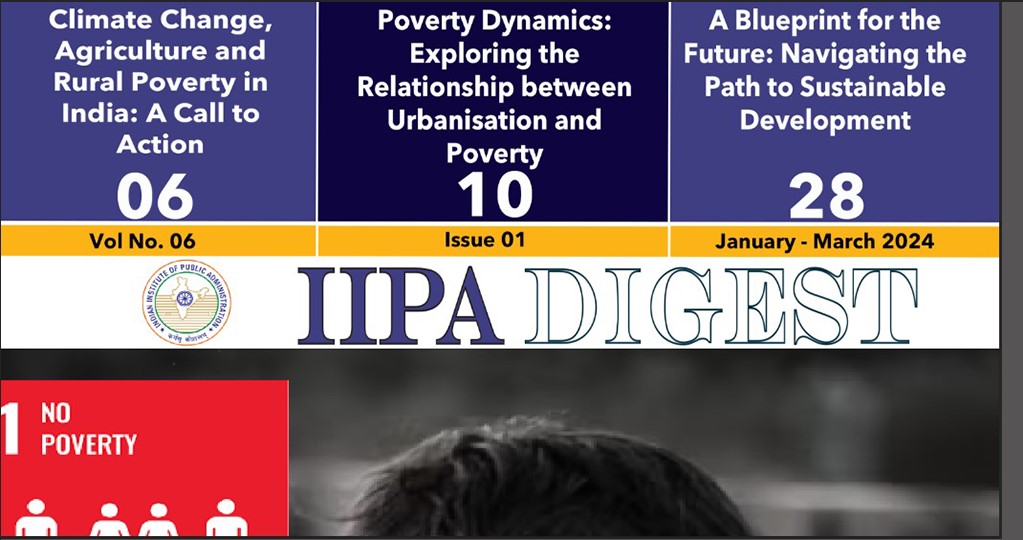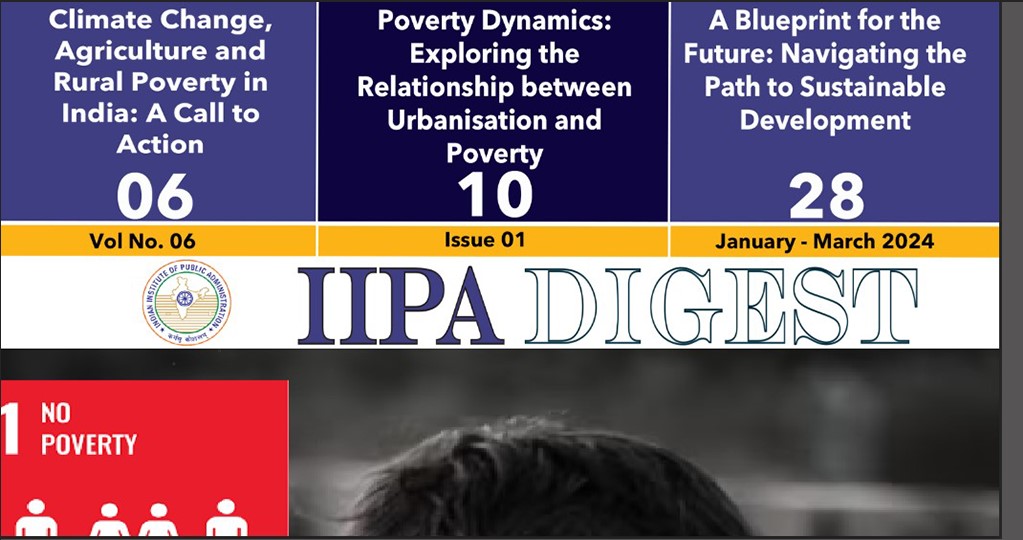Livelihood Imperatives and the Paradox of Plenty: The Minor Forest Produce Economy and Policy Interventions in India
Abstract
The paper provides a detailed insight into the vast MFP (Minor Forest Produce) economy of India, a sector crucial to the livelihoods of about 100 million tribal and forest-dwelling people. This big paradox of the MFP economy - huge natural wealth and traditional ecological knowledge coming into existence side by side with continued economic marginalization of its bottom-most collectors - is interrogated. This analysis unravels the paradoxical situations wherein these collectors, legally possessed of rights via landmark legislations like the Scheduled Tribes and Other Traditional Forest Dwellers (Recognition of Forest Rights) Act, 2006 (FRA), and the Panchayats (Extension to the Scheduled Areas) Act, 1996 (PESA), confront de facto economic disempowerment caused by peculiar market malfunctions, infrastructural handicaps, and institutional drawbacks. The paper then turns to analyse the "Mechanism for Marketing of Minor Forest Produce through Minimum Support Price (MSP)" scheme based on the use of empirical case studies to demonstrate how its influence on local market forces and community bargaining power is catalytic but nevertheless highly vulnerable. The paper concludes that the sector requires a market-systems approach policy, relaxing the welfare schema from sustainability and equity perspective. This, essentially, focuses on strengthening community-level institutions and building decentralized infrastructure for value addition; besides enabling the environment for community-led enterprises, converting the legally recognized rights into economic prosperity for reality.
Key words: Livelihood, Minor Forest Produce, Minimum Support Price, Forest Economy
The Forest Economy: Livelihood Imperatives and the Paradox of Plenty
Rural India, filled with forested zones, centers its economic activities on the collection and trade in MFPs. It is estimated that 100 million forest dwellers depend directly upon these natural forest resources for their sustenance and livelihood. For these communities, the forest is not a secondary resource but rather the basis of their economic life. Dependence on forest produce is specially greater among tribal populations in India; around 90% of them live in rural areas, often inside or adjacent to forests, where their survival depends on forest produce collection.
Minor forest produce takes on a dual role in these local economies: it is secondary subsistence and an important means of making cash income. On the one hand, it provides local households with various important goods for direct consumption, food fruits, nuts, medicinal, fodder for animals, and firewood for cooking, thus limiting market dependence on their side for these basic goods (IIPA, 2020).2 On the other hand, sale of the excess set MFP as a source of very crucial monetized income. Such income becomes very precious during the "lean season" of agriculture, a time when very little farming activity takes place and other maintenance jobs remain quite rare. So in these seasons, it is actually a basic financial cushion while from a social perspective it serves as a safety net against the risks of agricultural shocks, climate variability, and endemic poverty (Ministry of Tribal Affairs, 2019). Hence, the phrase "Minor Forest Produce" is one of the grossly misleading term with regard to the economic significance of the produce; for millions of poor families, it is a major avenue for building livelihood resilience and food security.
This deep reliance on forest resources presents a profound paradox at the heart of India's rural developmental challenge: the coexistence of infinite natural resource wealth and ever-present human poverty. The MFP sector is endowed with superlative economic potential, hypothesized to be worth trillions of rupees annually in some estimates. Nonetheless, the primary collectors of MFPs, those with traditional knowledge of identifying, harvesting, and performing the first stage of processing of these products, rank among the most marginalized and poorest in Indian society (Ministry of Tribal Affairs, 2019). This paper holds that the economic disenfranchisement of MFP collectors is neither incidental nor accidental but rather a consequence of systemic market failure, deep-seated structural impediments, and the continued existence of policy lacunae that have worked against the very realization of resource rights enshrined in law.
Fifth Schedule of the Indian Constitution
The British envisaged a policy that entailed exclusion of the tribal areas from the colonial administration prevailing in the other parts of India. The concerned provisions in the Government of India Act, 1919 and the Government of India Act, 1935 popularly embodied this policy of the British. The understanding of tribes as backward and different very much informed the debates of the Constituent Assembly on tribes1. The need to treat tribes differently within the new Indian nation was popularly underscored. Accordingly, the Fifth and Sixth Schedule were introduced to the Indian Constitution with the latter pertaining to the tribal areas in the North East and the former to the tribal pockets in the other parts of India.
The British advocated the protection of tribal areas but simultaneously facilitated assimilation with the mainland through the market. The formation of distinct tribal areas in terms of geographical territory commenced within the colonial period and were thereafter called Scheduled Tracts. The Government of India Act, 19192, changed the name of Scheduled Tracts to Backward Tracts. These were then divided into wholly excluded areas and partially excluded areas. In the partially excluded area, no general laws could be applied unless approved by the Governor General. Early in the post-independence period, there came a reversal of this principle. Instead, such laws would be applicable in Fifth Schedule Areas, unless the Governor specifically modified the application of such a law.
Post-independence debates regarding the administration and welfare of tribal committees evolved two major approaches with regard to tribal society. On the one hand, GS Ghurye was in favor of assimilation whereby he considered tribal societies, in effect, as Hindus who should be integrated into the Hindu mainstream. On the other hand, Verrier Elwin had expressed that tribal societies had their peculiar traditions and customs that should get preserved and maintained. Therefore, the present governmental approach has been to preserve the traditions and customs of the tribal communities but at the same time ensure that there is no isolation through the implementation of policies and programmes for their socio-economic upkeep.
For much of the post-independence period, forest governance remained dominated by the shadow of the Indian Forest Act, 1927. In line with forestry objectives vis-à-vis timber extraction and revenue generation for the state, this legislation, in its classic colonial sense, nationalized forest resources and turned erstwhile traditional forest-dwellers into encroachers on their ancestral heritage. An important mode of doing this was the declaration of certain resources as economically important. Bamboo is only one example; one of the most significant tribal economies in India termed "tree" and put it into sole control of the Forest Department, thus cutting the community off from its one livelihood resource.
PESA: Self-governance and Tribal Autonomy
PESA, The Provisions of the Panchayats (Extension to the Scheduled Areas) Act, 1996, has done the enlargement of the Panchayati Raj system in Scheduled Areas. It was felt that in Scheduled Areas, especially those under the Fifth Schedule, development and prosperity should come in, sans disturbance to the unique traditions, customs, and modes of living of the communities inside these areas.
The Committee on the Development of Scheduled Tribes, under the chairmanship of Dr. Bhuria in 1994, had recommended certain important measures to be adopted for the development of tribal communities in Scheduled Areas. These recommendations ultimately culminated in the enactment of PESA in 1996, extending the governance of Panchayats in Scheduled Areas. Through the provisions of the Act, Gram Panchayats and Gram Sabhas were supposed to be empowered particularly in matters relating to alienation of land and restoration thereof, control over local plans and resources, ownership of minor forest produce, recognition of tribal customs and traditions, resolving disputes, and community resource management. The sole aim of this Act was to strengthen village level institutions and make governance more inclusive so that the tribal communities may have a say in their development and thus addressing the issues of disenchantment and discontent that go along with people in these areas. The most important feature of PESA was the empowering of the Gram Sabha or the village assembly. Some of the important provisions of PESA were:
i. Definition of a village not as an administrative unit but as a social unit by laying emphasis on the hamlets or habitations with a set of traditions, customs, and methods of resource management
ii. Recognizing the competency of the Gram Sabha in safeguarding the traditions, customs and practices of the people especially with regard to resolution of disputes
iii. Power to the Gram Sabha to approve plans and programmes for the development of the village and to select and identify beneficiaries for poverty alleviation programmes
iv. Consultation with the Gram Sabha in matters of land acquisition
v. Mandatory prior recommendation of the Gram Sabha in matters of granting license for mining of minor minerals
vi. Power to the Panchayat at the appropriate level (PAL) for management of minor water bodies
vii. Powers to the Gram Sabha and the PAL to regulate or prohibit intoxicants, own minor forest produce, manage village markets, prevent land alienation, control money lending and control plans including tribal sub-plans
viii. Representation of Scheduled Tribes in the Panchayat and reservation of all seats at the level of the Chairperson for Scheduled Tribes
PESA is important precisely because it recognizes the capacity of the tribals for self-governance. Some academics and researchers point out that the emphasis on the Gram Sabha might not work because in tribal communities in the present day, the Gram Sabha is not necessarily an important institution given that these communities have been exposed to some extent to modernity and change. However, it is important for the Gram Sabha to become an active institution in order to safeguard the interests of these communities. PESA is flexible enough to accommodate such changes.
FRA's economic provisions
The core of the FRA's economic provisions is in Section 3(1)(c), which recognizes, and vests forest dwellers with, the right to ownership, access to collect, use, and dispose of MFP traditionally collected either within or outside their village boundaries (Forest Rights Act, 2006). This provision goes much beyond PESA by vesting such rights directly in the individuals and communities and not merely in the Gram Sabha as an institution. While rights to "collect" and "use" guarantee subsistence, it is the right to "dispose" i.e., sell it in the open market-which holds the economic interest of the Act. This solitary word gives legal impetus to the conversion of MFP from a subsistence good into a commercial commodity, thus theoretically enabling collectors to enter into the market on their terms.
• Thus, the laws PESA and FRA are complementary in their function and serve to disenfranchise resource governance from state bureaucracy and vest it in truly democratic institutions at the community level. PESA provides the institutional mechanism-the empowered Gram Sabha-through which the individual and community rights to ownership, access, and marketing of MFPs as guaranteed by the FRA may be managed and exercised in a collective manner. In this way, both Embarking on this journey will give birth to a mighty set of legal parameters for local self-governance-the one that stands in direct antagonism to a century of state-based, top-down forest management. The central debate in the MFP economy is, however, as the analysis below will indicate, that great and obstinate chasm-gulf between those rights granted to communities de jure and their capacity to exercise them, de facto, in any meaningful and remunerative manner.
The Unstructured Value Chain: Structural Barriers to Economic Realization
The Report published by the Committee of Officers on Issues Relating to Minor Forest Produce in the PESA States provides valuable insights into the working of the economic aspects of the Gram Sabhas and Panchayats in the PESA states. The Committee was constituted by the Panchayati Raj Department in the Government of India, vide its Order No. PR- 11011/3/2006-P&J to study issues relating to Minor Forest Produce (MFP) in the PESA States. The committee was entrusted to identify and analyze lapses in the structure of the distribution of MFP which in turn would ascertain a level of autonomy and responsibility accorded to the Gram Panchayats and the Gram Sabhas in the respective PESA states.
According to the report, there is a lack of uniformity in appropriating the forest produce and simultaneously benefitting the local population. The report suggests that PSEs engaged in social sectors (such as the FDCs/TDCs FEDs) whose primary responsibility is the welfare of Tribal and other backward sections of the society [seeking to eliminate exploitation by open market forces] have to face the predicament of profit versus welfare almost every day.
The report is comprehensive on a number of grounds. Yet, it fails to mention some of the most integral aspects of economy in a tribal society functioning under PESA. There has been little or no mention of the kind of tribal representation in the PSEs in major activities involving the extraction, distribution, and sale of MFP. It also fails to take into account the existence of a parallel thriving economy functioning under the patronage of left wing extremists. Some reference to the role played by these elements in the local economy, the concurrent losses suffered by the PSEs and the tribals, the role played by the state administration in the entire scheme of things could have been better explained for a more holistic understanding of the indigenous economy.
However, the report does provide some useful recommendations for future references and studies as well as future policy formulations for the government. The report points out that the appointment of ‘phad munshis’ has been very beneficial to states like Madhya Pradesh and Chhattisgarh as decision-making has been decentralized and adopted in a democratic way. It suggests other states to follow the example rather than having a hereditary model. On a foundational note, it recommends an urgent need to create awareness about the provisions, aims, and objectives of PESA amongst Government functionaries. For this purpose, Central and State Governments need to launch training programs, and this subject could be included in the curricula of compulsory vertical training courses
Policy Imperatives for a Sustainable and Equitable MFP Ecosystem
The low returns for forest gatherers are attributable to numerous factors but the main ones are market inefficiencies and policy distortions. The low income of gatherers can also generally be ascribed to the result of the dispersed and uncertain production combined with fluctuating demand and undeveloped markets.
It is suggested to set up promotion of marketing boards, the role of the Marketing Board would be to provide information on markets and prices to the MFP gatherers and organize them by self-help groups.
Further the government should encourage direct linkages between large buyers (e.g. exporters of herbal medicines) and the villagers by the government. This has worked in some areas, for example, manufacturers bought anole directly, which has increased both production and the income of gatherers.
The government should take action to solve problems by creating proper marketing yards, market information systems, proper storage, and processing facilities at the local level. Simple processing activities, like making brooms, leaf plates, tamarind processing, mat and rope making, can be carried out in the household or cottage sector.
Since primary collectors and producers obtain the least amount of the value of their product, there is a need to increase the MSP rates. Not only would this provide the tribal farmers with a fairer price, but it would also promote agricultural investment and economic development and increase production. The criteria for MSP should be based on the current costs of production, not limited to historical costs.
a. Procurement agencies and gram sabhas in the significant tribal states have inadequate storage, which causes spoilage of perishable NTFPs and seasonal products. If the procurement quantities are low, as they often are at each Haat bazaar, they need to be picked up and taken to aggregation points, and then to a centralized godown or cold storage. For aggregation, there is a need of godown at the block level to aggregate stocks from each Haat.
b. Lack of transportation decreases gatherers' participation. Procurement reforms need to take place on both fronts, coupled with aggressive procurement of local products; procurement could be carried out, even at the Panchayat level. There should be some kind of intervention in infrastructure at storage points, such as storage facilities and weighing bridges, to keep the products fresh for a longer time and prevent their spoilage.
c. Without any financial support, tribal women are unable to embark on farm forestry or mini-enterprises that could provide them with economic and social benefits. Financial institutions must be involved in promoting community micro-enterprises with a clear division of benefits. It will also be crucial to engage financial institutions and all public sector banks in the development of NTFP enterprises.
d. Cash payment was one of the reasons gatherers preferred to sell to private buyers, who could pay in cash, whereas government buyers did not. Likewise, public agencies for procurement must visit villages every season to pay cash for the produce.
e. Primary collectors should freely collect, process, and market NTFPs but, with their low bargaining power and high risk of exploitation by local traders, there should be special provisions to protect their interests. The principle of free trade should apply to all NTFPs except the three currently nationalised: Kendu leaves, Bamboo and Sal seeds, which the state should rather de-nationalize instead of regulating. Minimum Support Price (from the actual market price by giving an incremental margin) was the principle followed by Girijan Cooperative Corporation in Andhra Pradesh.
f. Tribal farmers do not have the skills and technical knowledge for scientific cultivation of MFPs. So much needs to be done to ensure skills upgradation and also development of suitable technologies for NTFP processing. NGOs, experts, and research institutions need to be actively involved in different areas of marketing and training support to primary collectors and their cooperatives, and R&D activities to develop enhancements to production and processing.
g. The training currently provided to tribals on MFPs is rather limited in scope, training most of the time is only about collection and primary processing, in isolation, value addition remains an important barrier to tribal development, hence training must include basic and advanced skills training components for primary collectors, processors, and traders, and other value change players (frontline staff).
h. If value-addition equipment and training were provided, MFP gatherers could achieve greater economic status. For example, appropriate machines to enhance processing for some products such as lac should be provided for use by the community at the Gram Sabha level.
i. Capacity development and training, and awareness building is essential for foresters, particularly the subordinate field staff, to appropriately confront with regards to accommodating community rights in forest conservation, biodiversity, and climate change.
j. Unfettered access and unsystematic collection and over-extraction have led to the depletion of non-timber forest products (NTFP) resources. Special measures should be taken to reduce the pressure on forests by cultivation of certain species outside of the forest area, and also an intensive conservation plan. An increase in production would support degrading natural forest nontimber forest products management.
k. Much price manipulation occurs in far-flung areas by unscrupulous private players when gatherers remain oblivious of the prevalent "MSP for MFP" scheme as well as the markets prices. Such situations place gatherers at inferior negotiating positions for better prices. It is thus imperative for market information flows to be actionable by extant agencies of the government. More relevant market information offered to the primary collectors would hence enhance their bargaining power.
l. The training available to respondents is more or less negligible. The training centers are located very far from their villages, with no transport being provided. It is a severe deterring factor for many gatherers. Up until this time, training programs limited in scope have majorly hindered good coverage. According to one tribal leader, the training is not field-oriented; rather, it is paper training, and the funds are misused.
The informal and unstructured nature of the MFP market essentially engenders disparities in profit distribution (IIPA, 2020).2 This very market failure is occasioned by the creation of a multi-layered network of middlemen, traders, and aggregators, who exploit the collectors' structural vulnerabilities, such as their weak collective bargaining power, and non-existent real-time market information, combined with an immediate need for cash, to force on them unfair terms (IIPA, 2020). Pricing of MFPs bears no relation to terminal market values; sometimes weights go unverified, and at other times there is unfair grading of produce, and the like (IIPA, 2020).3
Thus, the mode of payment is the key factor that sustains the middlemen's control over the chain. Right from collectors to local traders, it is a norm to set prices and offer instant cash against the collected produce, while government procurement agencies face unexpected delays in providing payments due to procedural red tape.1 In marginal subsistence households, where there is some income, even the promise of lesser cash amount immediately tends to be a stronger lure, forcing these people into the exploitative private trade network. Thus, the unorganized market situation remains not only a passive condition but also an actively maintained system benefitting intermediaries directly at the primary collectors' expense.
The Gendered Dimensions of the Forest Economy
Writing about the MFP economy without touching on the gender dimensions would be a shallow understanding of the process itself. Prevalent in this sector are ladies who gather most MFPs and are mostly responsible for the traditional ecological knowledge that sustains its harvesting (Ingram et al., 2016). This is closely linked to women's economic empowerment, as they are in most cases the ones who use or sell the products from collection.4 Thus, women act as the forefront. However, restrictions bearing their distinctive traits hamper their upward economic mobility and place them at the bottom in most cases in the value chain.
The MFP economy is characterized by a sharp gendered division of labor. Women are overwhelmingly concentrated in the physically demanding and time-consuming tasks of collection and primary household-level processing. In contrast, men tend to dominate the higher-value nodes of the chain, including transport, aggregation, large-scale trading, and any activity that requires large capital outlays or use of technology.5
This division is not an automatic one, but rather the result of a complex interplay between social and structural factors.
Several constraints systematically curb the upward mobility of women. Deeply ingrained social and cultural limitations often curtail their physical mobility, thereby putting a bar on their access to distant markets. Without doubt, women shoulder much more heavy burdens of household responsibilities, including childcare and houseworks, as compared to men, by which they get less time and energy for economic activities.6 And so, women have been systematically being faced with more barriers than men for access to critical resources, such as; lower level of literacy might prevent them from engaging with formal market systems; weak land tenure rights might forbid them from scourging forest resources; and, most importantly, lack of access to institutional credit and technology.7
Unequal access to resources creates disparities in expenditure patterns. According to research, a woman will most likely spend money earned via an MFP sale on basic domestic requirements, including food, nutrition, or children's education. Men, alternatively, may employ money earned for other business activities or personal expenses (Ingram et al., 2016).1 This differential exercise of income implies that economic empowerment of women in the MFP sector translates with immediate effect into greater household welfare and alleviation of poverty.
Women's work in MFP gathering is generally socially perceived as being less of a skilled economic activity and more as an extension of their domestic, reproductive labor. This contributes to the systemic undervaluation of their work, further eroding their bargaining power and compromising the prices they must accept. Hence, policies that formalize and remunerate this labor, such as the MSP scheme, constitute not only economic interventions but also acts of social and economic recognition upholding women's contributions' worth.
Yet policy interventions themselves carry risks if they are not formulated with a gender-sensitive perspective. Such an apparently neutral policy as credit for a processing machine may in fact reinforce the existing inequalities. As men typically have better access to capital, technology, and formal institutions, the program might mostly reward men. This could, further at the male end of the value chain that is processing, while doing more harm to the women who remain heavily engaged in collection, which is by far less remunerative. Thus, the policy must clearly be gender-sensitive and do so by earmarking funds, training, and technical support for the SHGs of women to enable them to collectively purchase, operate, and manage these assets. The all-women MFP collectives in Kandhamal offers a strong example of successful interventions that demonstrate that, once organized and supported, women have the capacity to contest and transform long-entrenched male-dominated market structures to capture a bigger share of the value they help create.8
References
1. Savyasaachi, Tribal Forest-Dwellers and Self-Rule: The Constituent Assembly Debates on the Fifth and Sixth Schedules (New Delhi: Indian Social Institute, 1998).
2. The Government of India Act, 1919 declared the tribal areas as ‘Backward Tracts’ and stipulated against application of any Act of Indian Legislature without being directed so by the Governor-General. Following this, the Government of India Act, 1935 declared the tribal areas as ‘Excluded Areas’ and ‘Partially Excluded Areas’ and prohibited the extension of legislation functioning in other parts of India to these areas.
3. Indian Institute of Public Administration. (2020). Mechanism for Marketing of Minor Forest Produce (MFP) through Minimum Support Price (MSP) and Development of Value Chain for MFP. TRIFED.
4. Ramasamy, U. (2014). Women’s Livelihoods: Emerging Opportunities in Forest Economies of India. Programme on Women's Economic, Social and Cultural Rights.
5. Ingram, V., Haverhals, M., Peterson, S., Elias, M., Sijapati Basnett, B., & Phosiso, S. (2016). Gender and Forest, Tree and Agroforestry Value Chains. In Gender and Forests: Climate Change, Tenure, Value Chains and Emerging Issues (pp. 221-242). Center for International Forestry Research (CIFOR).
6. Ingram, V., Haverhals, M., Peterson, S., Elias, M., Sijapati Basnett, B., & Phosiso, S. (2016). Gender and Forest, Tree and Agroforestry Value Chains. In Gender and Forests: Climate Change, Tenure, Value Chains and Emerging Issues (pp. 221-242). Center for International Forestry Research (CIFOR).
7. Ramasamy, U. (2014). Women’s Livelihoods: Emerging Opportunities in Forest Economies of India. Programme on Women's Economic, Social and Cultural Rights.
8. Pani, C. R. (2017, June 23). The silence on minimum support price for minor forest produce. Down To Earth.
9. Documentary Search | KGWS, accessed August 15, 2025, https://www.vmml-cwds.ac.in/documentary-search?f%5B0%5D=country%3A18&f%5B1%5D=resource-type%3Aarticle&f%5B2%5D=resource-type%3Ainstitutional_papers_reports&search=&sort_by=field_publication_year_1&page=22
10. Forest Rights Act, accessed August 15, 2025, https://www.fra.org.in/
11. Indian Institute of Public Administration. (2020). Mechanism for Marketing of Minor Forest Produce (MFP) through Minimum Support Price (MSP) and Development of Value Chain for MFP. TRIFED.
12. Ingram, V., Haverhals, M., Peterson, S., Elias, M., Sijapati Basnett, B., & Phosiso, S. (2016). Gender and Forest, Tree and Agroforestry Value Chains. In Gender and Forests: Climate Change, Tenure, Value Chains and Emerging Issues (pp. 221-242). Center for International Forestry Research (CIFOR).
13. IIPA Study | TRIFED - Tribes India | PMVDY, accessed August 15, 2025, https://trifed.tribal.gov.in/non/timber/iipa-study
14. MINOR FOREST PRODUCE (MFP) on MINIMUM ... - Govt. Ecommerce, accessed August 15, 2025, http://www.tdccodisha.org/MSPonMFP.php
15. Ministry of Home Affairs, Government of India. (1996). The Panchayats (Extension to the Scheduled Areas) Act, 1996.
16. Ministry of Tribal Affairs, Government of India. (2006). The Scheduled Tribes and Other Traditional Forest Dwellers (Recognition of Forest Rights) Act, 2006.
17. Ministry of Tribal Affairs, Government of India. (2019). Guidelines for Mechanism for Marketing of Minor Forest Produce (MFP) Through Minimum Support Price (MSP) & Development of Value Chain for MFP.
18. MSP for MFP Guidelines _MOTA.pdf - TRIFED, accessed August 15, 2025, https://trifed.tribal.gov.in/sites/default/files/2020-05/MSP%20for%20MFP%20Guidelines%20_MOTA.pdf
19. (PESA Act, 1996) - Ministry of Home Affairs, accessed August 15, 2025, https://www.mha.gov.in/sites/default/files/PESAAct1996_0.pdf
20. Pani, C. R. (2017, June 23). The silence on minimum support price for minor forest produce. Down To Earth.
21. POLICY BRIEF - TERI, accessed August 15, 2025, https://www.teriin.org/sites/default/files/2018-03/Policy%20Brief_Sustainable%20Harvest%20of%20Minor%20Forest%20Produce%20%28MFP%29_10-02-2018.pdf
22. Ramasamy, U. (2014). Women’s Livelihoods: Emerging Opportunities in Forest Economies of India. Programme on Women's Economic, Social and Cultural Rights.
23. Silence on MSP for minor forest produce - Down To Earth, accessed August 15, 2025, https://www.downtoearth.org.in/governance/the-silence-on-minimum-support-price-for-minor-forest-produce-58149
24. THE PROVISIONS OF THE PANCHAYATS ... - India Code, accessed August 15, 2025, https://www.indiacode.nic.in/bitstream/123456789/1973/1/A1996-40.pdf
25. THE SCHEDULED TRIBES AND OTHER TRADITIONAL FOREST DWELLERS (RECOGNITION OF FOREST RIGHTS) ACT, 2006 - India Code, accessed August 15, 2025,
https://www.indiacode.nic.in/bitstream/123456789/8311/1/a2007-02.pdf
26. The Energy and Resources Institute (TERI). (2018). Minimum Support Price of Minor Forest Produce (MFP) and Its Sustainable Harvest: A Social Safety Measure for MFP Collectors in India.
27. Tribal Development Co-operative Corporation of Odisha Limited. (n.d.). Minor Forest Produce (MFP) on Minimum Support Price (MSP). Retrieved from(http://www.tdccodisha.org/MSPonMFP.php)
28. TRIFED. (n.d.). MSP for Minor Forest Produce (MFP). Retrieved from https://trifed.tribal.gov.in/division/mfp-for-msp
Leave a comment
More articles from Urban & Rural Areas










